Hugo Lloris is required by Mauricio Pochettino to be a distributor as well as a keeper, but just how well is he doing?
The man between the sticks is not only a shot stopper with quick reactions, but our new coach also needs him to be an excellent distributor as well.
Moving the ball to the right targets is key to maintaining possession and getting play moving vertically, one of the objectives of the new manager’s system. Therefore, Mauricio Pochettino requires a keeper who is comfortable with the ball in his gloves as well as at his feet.
There are four zones that the goalkeeper needs to reliably hit:
1. The centre backs that split very wide.
2. The defensive midfielder who drops between the two centre backs.
3. The full backs who are pushed up extremely high.
4. The centre forward either through the air or with a lower driven ball to feet when he comes shorter.
We can see a good cross section of this distribution from Pochettino’s time in charge of Southampton in their Premier League match with Manchester City at St. Mary’s.
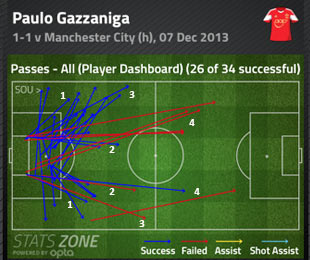
Paulo Gazzaniga manages to hit most of these zones, only really failing with passes to the striker, the hardest and most difficult ones to find. This is due the distance involved to deliver the pass giving the defence more time to react. It can also see the striker being outnumbered against the centre backs, whilst often it is a clearance downfield played under pressure.
We’ve seen both our keepers already adopt Pochettino’s four zone passing policy in pre-season. Here, Brad Friedel easily finds one of his centre backs as Kaboul and Veljkovic split wide with Capoue dropping in.
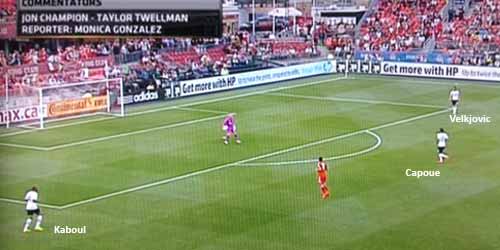
Whereas here, Toronto bring two additional pressing players, so he looks for the longer pass out to Kyle Naughton in the right back slot.
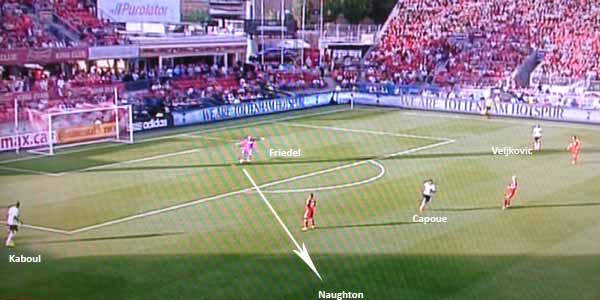
This is a more technical ball to play and requires a keeper who is comfortable playing a lofted pass over distance.
Hugo Lloris against West Ham
After seeing both Brad Friedel and Hugo Lloris hit a number of these passing zones in pre-season, our French stopper was given a baptism of fire against West Ham.
Big Sam is known for his spoiling tactics and clearly had a plan to close Lloris down, which was only accentuated after Kyle Naughton’s sending off.
Before Naughton was given his marching orders, Hugo Lloris was managing to distribute the ball quite well, albeit under some pressure. He was finding his centre backs splitting wide (1) and occasionally his defensive midfielder dropping in (2) and the full backs pushed high (3).
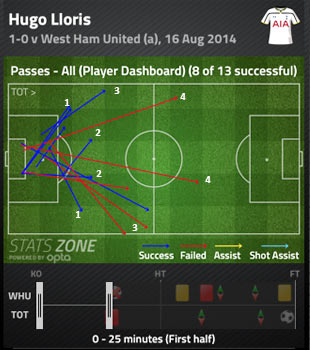
Once down to ten men, his distribution was more difficult. Although he was able to find his wide splitting centre backs on occasion, he was forced to go downfield far more often due to the numerical disadvantage.

Lloris’ passing accuracy had dropped, but the state of the game was heavily influential.
Hugo Lloris against QPR
After the trip to Upton Park where building from the back had been a problem, QPR came to the Lane and we saw the exact opposite.
After Big Sam’s tactics to bring some pressure, Harry Redknapp had his charges drop off and sit back. Distribution for Hugo was much easier as we controlled possession and tempo in the game.
Lloris was easily able to find his wide splitting centre backs and his defensive midfielder dropping in between them. What’s more, distribution to the full backs was much closer to our goal without much pressure from the opposition.
In fact, the only passes Hugo Lloris failed to complete were the ones to the centre forward. Emmanuel Adebayor was up against three centre backs for the first half and then two in the second. Interestingly, all three of these incomplete passes to him were after the interval when QPR switched to a back four and were chasing the game.
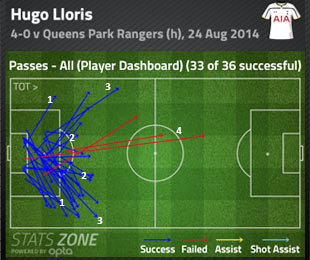
Hugo Lloris against Liverpool
After the ease with which Hugo Lloris could hit his targets against QPR dropping off, Liverpool came to town and pressed extremely high. This had the effect of once more forcing Hugo Lloris to go long.
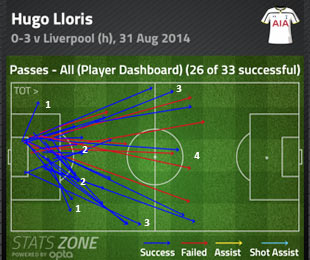
Lloris hit 25 passes to his split centre backs and defensive midfielder dropping between them in the match with QPR. Against Liverpool, he managed to find them just 11 times, as the Reds cut these options off and forced him to go downfield.
The way Liverpool set up with their twin strikers to make Hugo Lloris look further up field can be seen from his passes to our full backs. Eric Dier, operating at right back, was able to take the ball much closer to his goal against QPR. Whereas Dier is up at the halfway line versus Liverpool, who got in between him and Lloris.
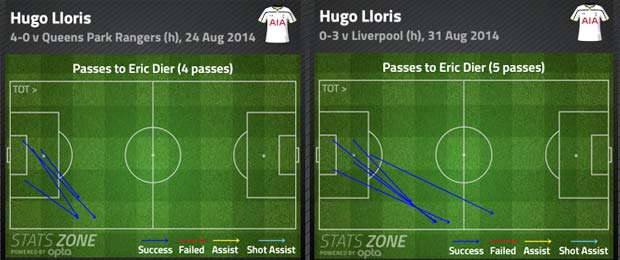
Despite the Reds’ pressing, Hugo Lloris was still quite on-point with these longer passes that he had to play, completing 26 of 33 (79%). His most accurate game of the Premier League season so far.
Hugo Lloris having to adapt his distribution
We’re only three games in to the new Premier League season and already Hugo Lloris is adapting his distribution to what Mauricio Pochettino requires.
His success rate to hit the four zones that the new coach wants has varied from opposition to opposition.
West Ham and Liverpool both had plans for him with varying degrees of success. Us going down to ten men accentuated the Hammers’ tactics. Liverpool had a better overall plan with their twin-striker diamond formation, but couldn’t throw Lloris off course despite forcing him to kick the ball longer.
Overall, Hugo has made a good start to getting our attack moving in the way that Mauricio Pochettino wants. His completion percentage is good, but If he experiences a dip in form, then the coach has a ready made replacement in Michel Vorm.
The Dutch stopper has already shown that he will be a good fit for our new coach’s system, as this is the exact way that Swansea moved the ball out from the back. A primary reason why Pochettino got him in, so he now has two top distributors.
We can see this from our match with Swansea at the Lane last season, where Vorm tried to find the same four zones that Pochettino wants his keeper to hit.
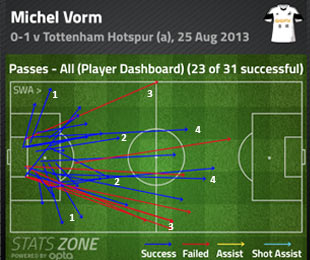
If Hugo Lloris suffers a dip in form, then Vorm will be ready to step in and replace him. What’s more, Pochettino now has an interchangeable back up in the event of injury, rest or rotation.
Hugo Lloris is still making the great saves. Adapting his distribution method from what was required under AVB and the long kicking days of Tim Sherwood are showing what an excellent all round keeper he is.
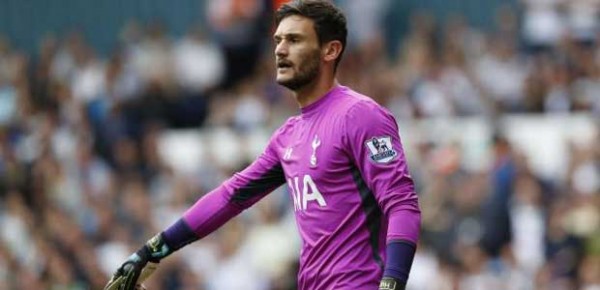
Lloris is easily one of the best shot stoppers in the Prem but must unfortunately be the worst distributor ever to play for Spurs
I can think of plenty worse at distributing the ball (Walker, Gomes), personally think Lloris is pretty decent at it.
Just for some balance… I’m right in the middle. ;) I think he’s often poor, but does have that arrogance you need in a sweeper/ball playing keeper.
He certainly does mess up some clearances when he’s rushed.
That he does, but many ball playing keepers are when hurried. Michel Vorm is also very good with the ball at his feet and was an integral part of the way Swansea moved the ball around at the back, but he too can be pressured in to miscued clearances. Often when you get a bad or heavy hit pass back, or its on the keeper’s weaker foot, then he can only just try and send it forward or out. Fear of slicing one or just plain whiffing on it are also a factor, especially when on the weaker side.
Nice piece, but hold on your horses! Lloris’ distribution has been meh since his debut. He progressed though, for the ball stays on the pitch, you should see him at the age of 19-20 ! I hope that PoMo won’t count too much on it ! COYS
You reminded me here of your prediction pre-season about Poch’s systems weakness being against 2 strikers, spot on again Mark.
I wouldn’t swap Loris for any other Keeper I can think of,
also I love shouting out “sweeper keeper” everytime our defence is caught out ;-)
Those moments where Lloris comes flying out really are something exciting!
Two strikers against teams that like to build from the back can cause them problems. Although, like Everton and Liverpool, who have both switched to a possession based build from the back system, i think it’ll take time and there’ll be teething troubles.